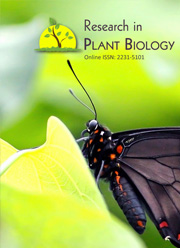Evaluation of some genotypes of maize (Zea mays L.) for tolerance to Striga hermonthica (Del.) Benth in Northern Ghana
Keywords:
Maize, Striga tolerance, savanna, GhanaAbstract
ABSTRACT
A study was conducted in Nyankpala, northern Ghana, to screen twenty five genotypes of maize for tolerance to Striga hermonthica during the 2012 and 2013 cropping seasons. The genotypes were evaluated under pot and field conditions to determine the effects of Striga infestation on yield as well as agronomic characteristics of maize. For the pot experiment, seeds of the maize genotypes were planted in green house pots that were arranged in rows on a platform with a distance of 1 m between the rows using complete randomized design. The pots were infested with Striga two weeks before planting maize. In the field, maize and Striga seeds were both planted at stake on the prepared plots using 1% germinable Striga seed-sand mixture based on a pre-determined 70% purity and 65% germination of the Striga seed. There were non-striga infested maize plants and these were considered as control or ‘normal’ plants. Results showed that the following three maize genotypes: TAIS03, DT-STR-W-C2 and IWD-C3-SYN-F2 were highly tolerant, whilst the following six genotypes: TAANO4, NYAZ03-Y, KOBN03-OB, SISF03-OB, NYIA03 and CHFB04-OB were moderately tolerant. The remaining genotypes showed moderate to high levels of susceptibility to Striga infestation. Striga count, Striga plant rating and anthesis-silking interval were significantly reduced (P < 0.05) in the control treatments as compared to the infested genotypes. Grain yield, plant and ear height, days to anthesis, days to silking, leaf area, chlorophyll content, fresh and dry shoot weight and root length also increased significantly (P < 0.05) in the control as compared to the infested plants. This study has revealed that maize genotypes such as TAIS03, DT-STR-W-C2 and IWD-C3-SYN-F2, or their crosses may be used in Striga-infested fields for increased growth and grain yield.



 .
. 